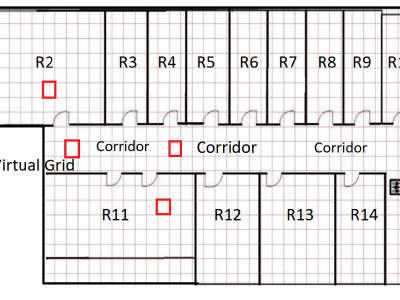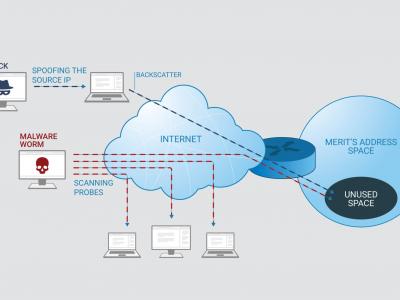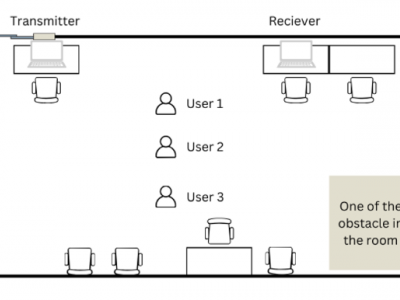Wireless Networking
The performance analysis of goodput measurements, underscores the superior transmission capabilities of MP$^2$-QUIC. Initially, the solution maximizes transmission rates to approach the optimal PSNR before rapidly stabilizing at a rate of 2766.56 Kbps. By comparison, Rand-SNC, Bats-SNC, and WindWrap-SNC stabilize at goodput rates of 1209.61 Kbps, 2260.84 Kbps, and 2317.65 Kbps, respectively. Throughout the simulation, MP$^2$-QUIC maintains an average goodput of 3071.62 Kbps, reflecting improvements of 2.29-fold over Rand-SNC, 1.25-fold over Bats-SNC, and 1.20-fold over WindWrap-SNC.
- Categories:
 114 Views
114 Views
Recently, the Wi-Fi community has focused on improving privacy measures, beginning with the introduction of Randomized and Changing MAC addresses (RCM) to mitigate privacy concerns during Pre-Association Discovery (PAD) mechanisms. A significant advancement has been the establishment of the IEEE 802.11bi Task Group (TG), known as Enhanced Data Privacy (EDP), which targets various aspects of privacy. Current EDP efforts concentrate on developing frame anonymization techniques to mitigate the issue of presence monitoring of associated STAs.
- Categories:
 72 Views
72 ViewsThis dataset is shared as part of the paper Towards scalable and low-cost WiFi sensing: preventing animal-vehicle collisions on rural roads, submitted to the IEEE Internet of Things Journal (IoT-J). It contains Wi-Fi Channel State Information (CSI) data from roadway crossings of small and large animals, persons and vehicles in rural environments.
- Categories:
 191 Views
191 Views
This MATLAB script implements a simulation framework for an IRS-assisted IoT network with multiple nodes in a 3D environment. The code integrates a number of advanced wireless features, including elevation-aware IRS phase alignment, dynamic spectrum sensing for channel allocation, inter-node interference modeling, and Doppler effects from node mobility. Operating at microwaves with configurable elements, the system achieves realistic performance metrics through iterative optimization.
- Categories:
 93 Views
93 Views
- Categories:
 68 Views
68 ViewsThe JU-Impact Radiomap Dataset is a comprehensive dataset designed for research and development in indoor positioning systems. It comprises 5431 instances characterized by readings from 105 static Wi-Fi Access Points (APs) and spans 152 distinct virtual grids. Each virtual grid represents a 1x1 square meter area, derived by dividing a physical floor of a university building into reference coordinate points (x, y). The dataset was collected over a period of 21 days using four mobile devices: Samsung Galaxy Tab, Moto G, Redmi Note 4, and Google Pixel.
- Categories:
 156 Views
156 ViewsNetwork telescopes collect and record unsolicited Internet-wide traffic destined to a routed but unused address space usually referred to as “Darknet” or “blackhole” address space. Among the largest network telescopes in the US, Merit Network operates one that receives unsolicited internet traffic on around 475k unused IP addresses. On an average day, the network telescope receives approximately 41.5k packets per second and around 17M bits per second. Description of the attached dataset:
1. Data Source:
- Categories:
 208 Views
208 Views
The 5G cellular technology has introduced advanced radio communication protocols and new frequency bands and enabled faster data exchange. These improvements increase network capacity and establish a foundation for high-bandwidth, low-latency services, helping the development of applications like the Internet of Things (IoT). However, information security poses significant challenges, particularly concerning attacks such as Fake Base Stations (FBS) and Stream Control Transmission Protocol (SCTP) Session Hijacking.
- Categories:
 343 Views
343 Views
The benchmarking dataset, GenAI on the Edge, contains performance metrics from evaluating Large Language Models (LLMs) on edge devices, utilizing a distributed testbed of Raspberry Pi devices orchestrated by Kubernetes (K3s). It includes performance data collected from multiple runs of prompt-based evaluations with various LLMs, leveraging Prometheus and the Llama.cpp framework. The dataset captures key metrics such as resource utilization, token generation rates/throughput, and detailed inference timing for stages such as Sample, Prefill, and Decode.
- Categories:
 359 Views
359 ViewsThis paper presents the methodology and outcomes of a comprehensive dataset collection using ESP32-Nodemcu devices and the ESP32-CSI Toolkit. The dataset, designed to explore the capabilities of Channel State Information (CSI) in distinguishing human activities, was collected in a controlled indoor environment under three scenarios: single-user, two-user, and three-user setups.
- Categories:
 285 Views
285 Views



